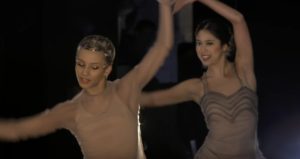Chelsea Bradley, a freelance choreographer based in Madison, Wisconsin, where she teaches contemporary at Monona Academy of Dance and serves as resident choreographer for Dance Wisconsin, gives us the following steps.
1. Find your spotSpotting is easy in the studio. I often tell my dancers to use the mirror to look themselves in the eyes. However, when there is no mirror, we must adjust. The most common item in convention center ballrooms and theaters are “exit” signs. If there are none, look for non-moving lights or visible signs.
2. Survey the floor
3. Check for distractionsIf you are able to look at the stage before you perform, consider the following to visualize the spacing of your choreography:
- Are there wings (and if so, how many)?
- How many strips of flooring (or tape lines) are there?
- Are there markings for center or quarter?
If you will be wearing pointe shoes, always have rosin with you in case the stage appears slippery.
4. VisualizeBeing aware of these distractions before you dance makes it less likely that they will disrupt your performance.
Photograph by Mait Jüriado. (via)]]>Once you have surveyed your external surroundings, it is important to make sure that you are mentally prepared to perform. After you have warmed up, use an mp3 player to listen to your music.


